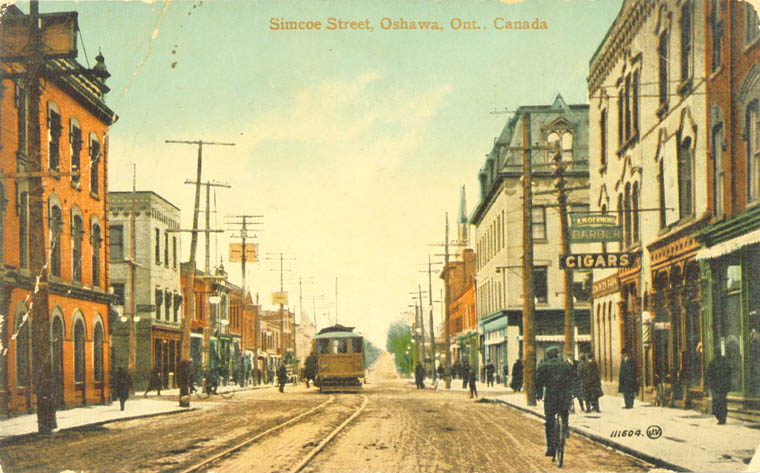
The Oshawa Railway began as the brainchild of Hugo Rathbun
and the head of his Rathbun Company, Captain R.C. Carter. This
far-sighted company saw a golden opportunity to supply Oshawa with building
products (lumber and cement) from Deseronto and Marlbank.
Potential also existed for the movement of freight and passengers from
the Grand Trunk Railway (GTR). All of these ends could be accomplished
profitably through a connection between the Port of Oshawa and its northern
limits at Ross's Corners (now Rossland Road). The idea was that this
new railway could move both passengers and freight to and from the Grand
Trunk Railway, which would no doubt aid in the development of Oshawa's
growing industrial base.
A new and exciting era had begun.
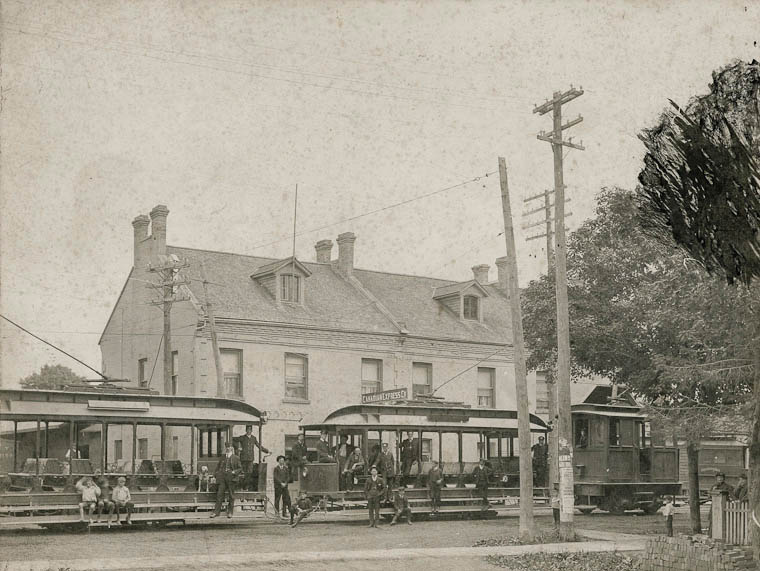
Two open cars and a tiny motor almost hidden. Building
in the background has Canadian Express Co. sign above car.
The Oshawa Railway and Navigation Company (ORN) was incorporated
on June 23, 1887 with F.S. Rathbun, (Hugo's son) and Captain R.C. Carter
as principals. The ORN's charter gave wide, sweeping powers authorizing
the railway to be built from Port Oshawa; north through Myrtle, Burketon,
Lindsay and Bobcaygeon to the Mattawa Junction with branches running
west to Whitby and east to Bowmanville (these never materialized).
The incorporation also included the power to work ferries on water touched
by the railway, buy or charter steamships and other types of craft,
conduct warehousing and wharfing business, and acquire by lease or purchase
all lands, elevators, docks, warehouses and real-estate required for
the efficient working of the company as authorized by the Parliamentary
act.
The incorporators were R.C. Carter, George Crawford, Allen Chadwick,
Robert Crawford, J.F. Wilson, W.F. Conan and James McGill. At long last,
with some of the red tape eliminated, things were ready to move on.
In 1891, the railway's name was changed to The Oshawa Railway and
progress had slowed to a crawl. There was much legal wrangling over
subsidies and right-of-way disputes. There was also vocal opposition
from Warren Mothersill declaring the railway to be "a waste of
time" and a statement made by Dr. Cosburn at a town council meeting
declaring the railway to be "a great swindle on a confiding people."
When things were finally ironed out, a perpetual franchise on certain
streets and a cash subsidy of $5,000 was granted.
In May 1894, after many delays, the rail yards of the GTR were suddenly
filled with building materials.
Construction was about to begin and Oshawa would soon become that town
with railway tracks down the main street.
The materials had finally arrived to begin construction
of the new railway. However, in 1898 F.S. Rathbun passed away and the
business was taken over by his son E.W. Rathbun. This change ushered
in many changes for the Oshawa Railway Company (OR).
The years between 1898 and 1910 saw continued debate within the company
and with the Town concerning the actual type of rails being used, their
locations, maintenance and the need for concrete paving between the
tracks and the remainder of the street. The debate was due to the fact
that the rotary brushes of the street sweepers used by the Town raised
a fusillade of pebbles, sand and snow and launched them against the
windows and walls of businesses surrounding the tracks. Needless to
say those affected were not pleased with this unforeseen development.
A compromise was reached. It was decided that the Town would establish
new grade and place new concrete foundations for the tracks. The company
would be responsible for providing and laying new ties and paying 60
per cent of the extra cost involved. This work was contracted out to
a firm from Windsor in the summer of 1911 and the project was completed
by the end of 1911.
On March 1, 1911, the Grand Truck Railway (GTR) assumed operational
control of the OR and one year later purchased all of its capital stock.
Even with this purchase, the OR remained a separate corporate subsidiary
with its own identity. At this time, the Canadian Northern Ontario Railway,
part of the growing Mackenzie/Mann Empire, built a line from Toronto
to Ottawa which ran through north Oshawa. They assumed construction
of the Toronto Eastern Electric Railway from a local syndicate which
involved R.S. McLaughlin. This new line entered Oshawa from the west
along a right of way, which passed through Kingsway College en route
to Bowmanville.
In 1913, a spur track was built on a private right of way running east
of Mary Street and connecting with the OR and the Toronto Eastern Railway
at Bond Street tapping into the growing amount of freight traffic from
Oshawa's expanding industrial base.
The First World War also spurred increased development of the railway.
The need for munitions and equipment for the war effort created even
greater industrial growth. Frequent streetcar service moved people to
and from work and home. More factory freight sidings were built and
shunters worked around the clock moving freight cars to and from the
three main line interchanges.
In 1923, with the GTR in bankruptcy, the Canadian government assumed
control of its holdings. Thus, the government became the owner of the
OR and with this all tracks in Oshawa became federal government property.
The Canadian National Railway (CNR) was the result. The OR continued
as a separate subsidiary under CNR ownership.
During this time, yet another wave of opposition was launched against
the OR led by Mayor Trick. He commented on the terrible state of the
streets on which the CPR had tracks and blaming congested housing in
central Oshawa on the fact that no new routes were being opened up by
the streetcars. He proposed a vote to facilitate a municipal takeover
of the railway. Nothing ever materialized from this proposal.
In 1924, the OR expanded north to Ross's Corners (now Rossland Road).
At this time, the Toronto Eastern tracks on Bond Street from Mary Street
to Ritson Road were incorporated into the OR. Approximately two miles
of the Toronto Eastern track to the Ontario Missionary College (now
Kingsway College) was kept, electrified and operated for freight service
from about 1924 to 1936, when service was abandoned with the exception
of a short piece of Ritson Road used by McCallum Transport for vehicle
loading and equipment turning on the Wye track.
In 1926, the former CNR spur from the North Oshawa yard was electrified
and operation taken over by the OR. The decision to do so was an attempt
to relieve the traffic congestion on the former South Oshawa/GTR interchange
that was created by the expansion of General Motors.
An underpass was constructed in 1932 on Simcoe Street South of Bloor
to replace the CNR level crossing and reduce the danger of collisions.
This did not affect the streetcars on Simcoe Street but sparked alterations
for freight access to the industries south of the CNR. When some of
the CNR mainline track was electrified from just east of Albert Street
to a point just west of Simcoe, a new connection was made from the CNR
to the Simcoe Street OR tracks just south of the new subway. This caused
a zigzag, a switchback manoeuvre for the OR electric trains to cross
the mainline rails which was quite time consuming.
The Depression had a devastating effect on rail service. On February
1, 1936 passenger service on the former CNR line running through north
Oshawa between Toronto and Port Hope was halted and freight service
on this line ended in 1938.
New advancements in technology, along with budget concerns, saw the
OR halt passenger streetcar service on January 27, 1940. The streetcars
were replaced by a fleet of nine Yellow Coach buses operated by another
CN subsidiary called Canadian National Transport Ltd.
The need for iron during the Second World War saw streetcar tracks being
torn up and melted down to be repurposed.
Operations of the OR were assumed by the Oshawa Public Utilities Commission
on December 3, 1959. The PUC decided to remove or pave over all tracks
on Simcoe Street plus any others not used for freight access. The OR
became a freight operation and prospered with the growth of the GM plants.
On May 11, 1963 a parade and celebration was held to mark the removal
of the tracks on King Street.
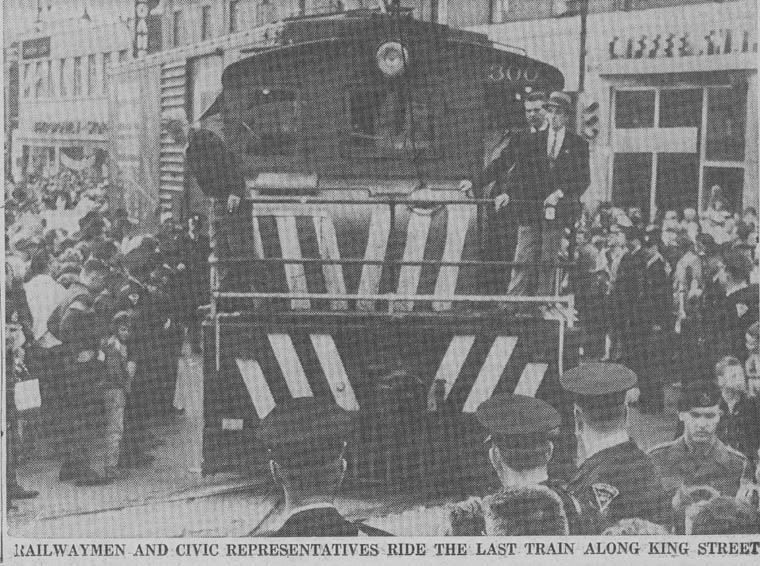
The Oshawa Times May 13, 1963 Old Time Trains Archives
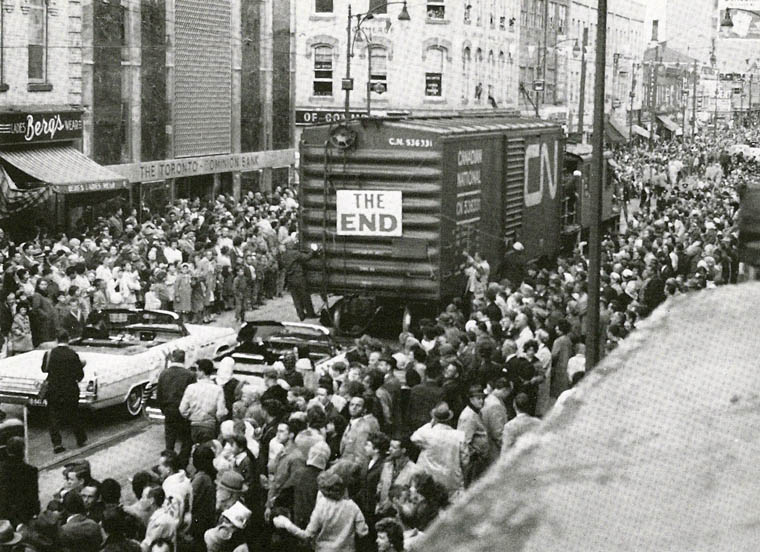
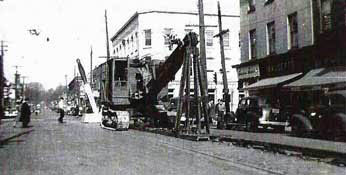
A projected date of May 31, 1963 was to mark the end of
all electrified freight operation with the remaining services to be
handled by the CNR using diesels but actual operations continued until
the end of the Oshawa Railway on June 27, 1964.
The legacy of the railway is examined in the new exhibit at the Oshawa
Community Museum
Tales from the Tracks: The Oshawa Street Railway.
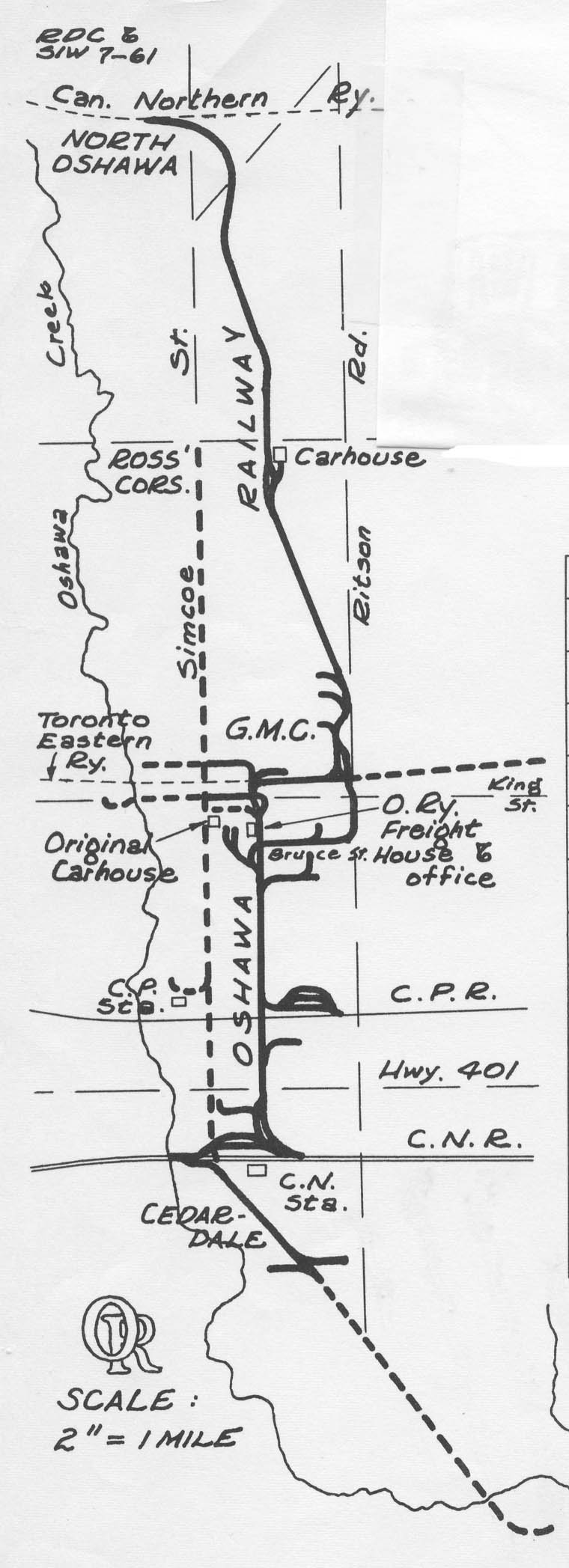
Old Time Trains Archives
Gallery of Equipment
